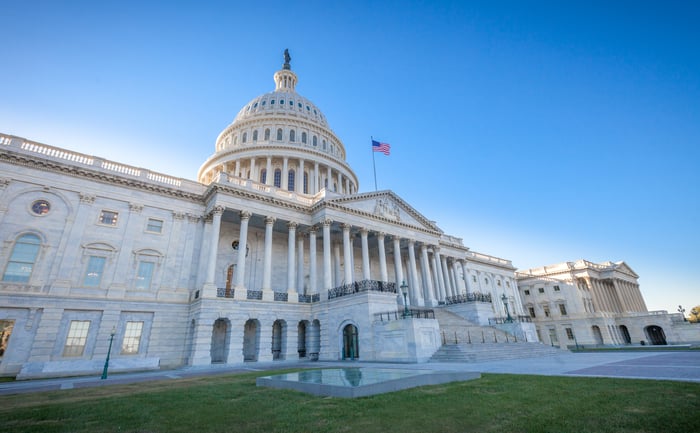You may not realize it, but it's the most important time of the year for nearly 65 million Americans. That's because October is when the Social Security Administration announces all of its updates for the upcoming year.
Once the curtain closes on 2020, we'll witness more than a half-dozen changes to Social Security, including an increase to the full retirement age for persons born in 1959. But the biggest change of all, and the one the more than 46 million retired workers value most, is the cost-of-living adjustment.

Image source: Getty Images.
Social Security beneficiaries have a raise headed their way
In its simplest form, COLA is a "raise" passed along to all Social Security beneficiaries to account for the inflation they faced over the past year. I say raise with quotation marks because it's not a raise in the true sense of the word. COLA isn't designed to allow Social Security's beneficiaries to get ahead. Rather, it's there to allow recipients' Social Security income to keep pace with the rising price of goods and services over time.
October is the most important month because Social Security's COLA calculation only factors in readings from the Consumer Price Index for Urban Wage Earners and Clerical Workers (CPI-W) in the third quarter (July through September). Since the Bureau of Labor Statistics reports September's inflation data during the second week of October, it becomes the last puzzle piece needed to calculate Social Security's COLA.
The coronavirus disease 2019 (COVID-19) pandemic has led to one of the wildest recessions in history, and some feared that possible deflation might stop the SSA from issuing a COLA. Social Security beneficiaries can breathe a little easier with the good news that they will indeed receive a raise in 2021. The Oct. 13 announcement from the SSA called for a 1.3% COLA come January.

Image source: Getty Images.
A 1.3% COLA simply isn't enough
But there's a downside, too.
A 1.3% payout increase ties for the second-lowest positive COLA of all time, trailing only the 0.3% increase passed along in 2017.
You might be thinking, "Hey, a 1.3% payout increase isn't much, but at least it implies that overall inflation is tempered." Unfortunately, that's not the case for senior citizens, whom the Social Security program is designed to protect.
The unadjusted inflation rate over the trailing-12-month period for two of the most important expenditures for seniors -- shelter and medical care services -- is handily outpacing 1.3%. This implies a coming loss of purchasing power for seniors in 2021. This would build on the estimated 30% loss of purchasing power to Social Security income since 2000, according to an analysis from The Senior Citizens League.
A 1.3% COLA simply isn't enough to true up retired workers' benefits with the inflation they're actually facing.

Image source: Getty Images.
Two lawmakers just introduced a bill to more than double next year's COLA
Understanding the plight that seniors are facing in the wake of the COVID-19 recession, two lawmakers -- Rep. Peter DeFazio, D-Ore., and Rep. John Larson, D-Conn. -- introduced the Emergency Social Security COLA for 2021 Act last week.
The goal of the bill is simple: to raise Social Security's COLA to 3% in 2021. That would more than double the announced 1.3% COLA and handily outpace shelter inflation (seniors' biggest single expense).
Both DeFazio and Larson have also called for switching the program's inflationary tether from the CPI-W to the Consumer Price Index for the Elderly (CPI-E), albeit not in the bill they introduced last week. The CPI-W is inherently flawed as Social Security's inflationary tether because it tracks the spending habits of urban and clerical workers rather than seniors, who make up the lion's share of beneficiaries. As a result, important expenditures for retired workers are underweighted in the COLA calculation, whereas less important costs (e.g., apparel and education) receive a higher weighting.
The CPI-E specifically tracks the spending habits of households with persons aged 62 and over. Using the CPI-E in place of the CPI-W should result in a more accurate inflation measurement and more robust COLAs over time.

Image source: Getty Images.
Will it pass? Probably not
The $64,000 question is whether the Emergency Social Security COLA for 2021 Act will pass Congress and be signed into law. The answer? Probably not.
As I write this just days after the bill was announced, there's a decent chance it will find its way to the floor for a vote in the Democrat-led House of Representatives where it was introduced. But it's unlikely to find its way to the Senate floor for a vote with Sen. Majority Leader Mitch McConnell standing in the way. That makes this bill dead on arrival in the Senate.
The wildcard here is that we're also 10 days away from Election Day, and increasing Social Security's COLA for seniors could be viewed as a feather in the cap for President Trump. That might put enough pressure on McConnell and other Senate Republicans to act. Republican lawmakers clearly don't favor using the CPI-E as the program's inflationary tether, but a bill focused on a one-time 3% COLA isn't entirely out of the question.
For the moment, I'm leaning toward this bill not becoming law -- but anything is possible.




